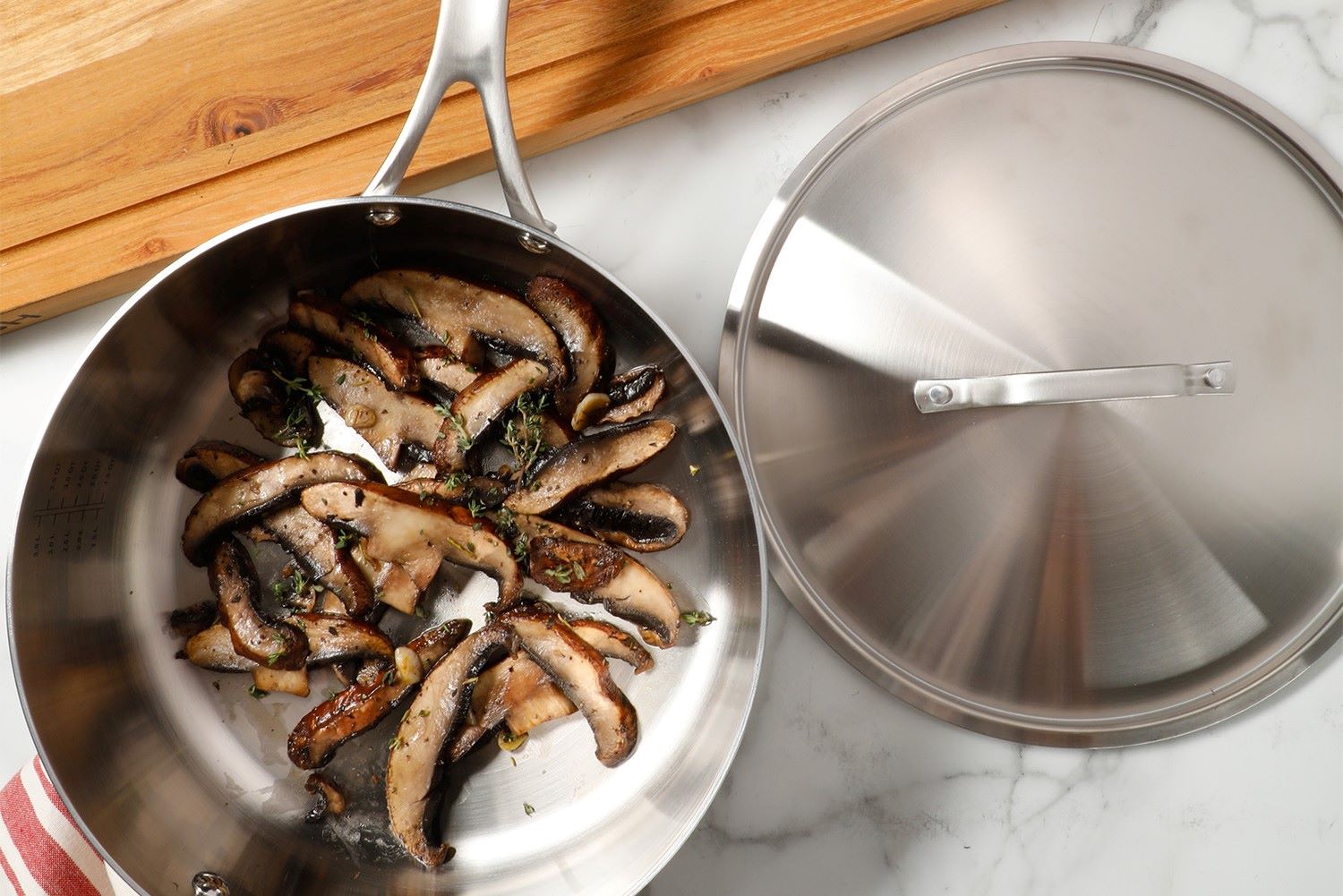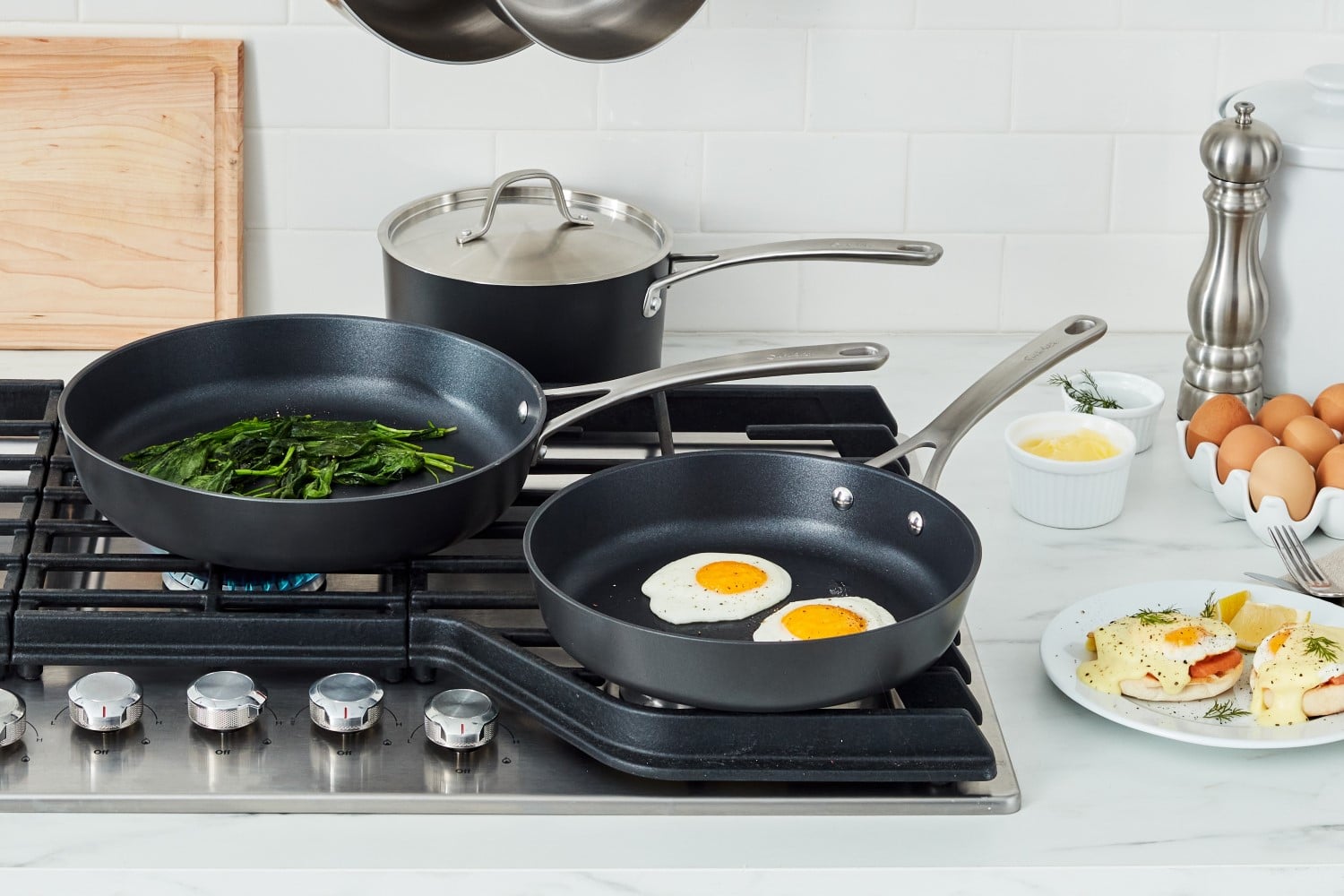Decisions, decisions.


When it comes to cooking at home, one of the most important decisions you can make is what type of pan to use. Whether you’re whipping up a simple omelet or taking a stab at a restaurant-worthy dish, the right skillet can make all the difference.
But with so many options on the market, it can be difficult to decide which one is best for your cooking needs.
Two of the most popular choices among chefs are stainless steel and nonstick. In fact, we recently launched our own lines of stainless steel and nonstick pans—Pike & Pine and Market, respectively—that are designed by chefs to give you that professional grade quality at home.
Both materials have their pros and cons, and each type is better suited for certain cooking needs and recipes.
Stainless steel pans are the go-to option for many home cooks. They’re durable, versatile and provide even heating, but they can be difficult to use at first because they take a little more patience and experience to ensure your food doesn’t stick.
Nonstick pans, on the other hand, are great for those who aren’t as confident in their cooking skills or who just want a simple, straightforward skillet for their kitchen. While they’re typically easier to use and clean, they’re not as durable as stainless steel pans and can’t withstand as high of temperatures.
Ultimately, the type of pan that’s best for you will depend on your budget and cooking needs.
In this guide, we’ll explore the differences between stainless steel and nonstick pans, so you can decide which is right for you.
Hungry for more? Explore our new Pike & Pine and Market collections to find the cookware that’s right for you!
The main difference between stainless steel and nonstick pans is the material they’re made from.
Stainless steel pans are made of a combination of metal alloys that are heat resistant and durable. They are often composed of iron, chromium and nickel, but some are made with a core of aluminum or copper—which are great conductors of heat—and coated with a stainless steel finish.
Nonstick pans, on the other hand, are usually made of a combination of hard anodized aluminum and stainless steel and are coated with a nonstick substance, most commonly Teflon and ceramic. This layer helps to prevent food from sticking to the surface and makes it easier to clean.

You won’t find many professional kitchens without a stainless steel skillet—they’re a do-it-all pan that can go from the stovetop to the oven, and you can cook almost anything in them.
They can be harder to clean, so knowing how to properly prepare your pan for cooking can help prevent sticking (hint: you need enough fat or oil plus enough heat—preheating is key—to create a sear or crust so your food will naturally release).
Pros of Stainless Steel:
Stainless steel cookware does have disadvantages, which may affect what recipes you choose to cook in this type of pan.
Cons of Stainless Steel:
Stainless steel pans are a great vessel for almost any dish, but they’re especially useful for stove-to-oven dishes. Steak, chicken and pork are great examples of this, as many recipes often require an initial sear before finishing in the oven.
They’re also incredibly versatile—because they’re non-reactive, stainless steel is great for cooking acidic foods, such as tomatoes or foods that contain lemon juice or vinegar. Stainless steel pans also are scratch resistant, which means they can be used with metal utensils, such as whisks, spatulas or turners.
Caring for your stainless steel pans is pretty straightforward and shouldn’t require much extra work than any other type of cookware. To properly maintain your stainless steel pan, the most important thing you need to do is simply let it cool completely before washing it, as quick temperature changes could cause the pan to warp.
While some stainless steel pans claim to be dishwasher safe, we wouldn’t recommend placing your cookware in the dishwasher. Soaking it in soapy water should do the trick for anything that becomes a little stuck on, but you can also use a non-abrasive scrub to help, too.
If something is really hard to remove, a little vinegar, water and heat is also a great way to clean your dish. It’s best to add this right after cooking, but if you let the pan sit for a bit, don’t stress. Just bring the vinegar and water to a boil, turn off the heat and use a wooden spoon to gently scrape off any bits. You can also let this cool and soak—stains and stuck-on food should come off easily with a quick scrub.

Whether you’re a home cook or a professional chef, nonstick pans offer several benefits that make them a great choice for nearly any cooking task.
Nonstick pans are a great addition to any kitchen and make preparing delicate foods—from eggs to seafood—much easier to cook. The slippery surface also means food doesn’t get baked onto the pan, making these pans great for everything from stir-frying and searing to sautéing.
Pros of Nonstick Pans:
While nonstick pans are a great cookware option for most dishes, there are a few drawbacks to consider.
Cons of Nonstick Pans:
If you’ve ever cooked in a kitchen, chances are you’ve come across a nonstick pan. Nonstick pans have become a must-have for most home cooks, as they allow you to cook food easily and quickly, and with minimal mess. But when should you consider cooking with nonstick pans over stainless steel ones?
Nonstick pans can be used for almost any dish but are best used for recipes that require delicate handling and a low cooking temperature. This includes dishes like scrambled eggs, omelets and pancakes, as well as foods that are prone to sticking, such as fish, vegetables and cream- or cheese-based recipes. Nonstick pans are ideal for these dishes because their slick surface prevents food from sticking and burning.
Nonstick pans are also great for cooking delicate sauces and other liquid-based dishes. Since the surface of a nonstick pan is so smooth, it allows the sauce or liquid to move around freely without burning or sticking to the pan.
Chef’s Note: Avoid using cooking sprays on your nonstick pans. This can leave a film on the surface that can affect the life of the nonstick coating.
As with any cookware, it’s important to take the proper steps to care for your nonstick pans to ensure they stay in top condition. To care for your nonstick pan, knowing what not to do is just as important. Here are a few tips to make sure your nonstick pan stays in tip-top shape:
Nonstick pans are generally considered safe to use.
Studies have indicated that some chemicals used to make nonstick pans—like PFOA or PTFE (Teflon)—can be toxic when heated to high temperatures, but the use of these chemicals has fallen out of favor in the last decade. In fact, Teflon pans made after 2013 shouldn’t contain the harmful chemicals they once did, and US- and Europe-made products should all be PFOA-free.
Today, there are also many more nonstick alternatives on the market, too, including ceramic nonstick cookware, which is naturally nonstick and free from the chemicals commonly used. When purchasing a nonstick pan, keep the following safety tips in mind:
So, when it comes to choosing between nonstick and stainless steel pans, it really depends on the type of food you cook and your comfort in the kitchen.
Many chefs use different pieces of cookware in a variety of materials to give them the flexibility and versatility they need to whip up any recipe. Consider buying both a nonstick skillet and stainless steel one, as this will offer the most options in your kitchen.
Hungry for more? Explore our new Pike & Pine and Market collections to find the cookware that’s right for you!
Informative article, thank you! I understand about heat differences but does the TYPE of heat matter? I.e., we have a gas stovetop . . it sounds like stainless steel would be better, unless my food time requires a much lower temp. Am I correct?